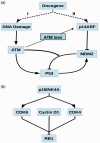Role of genomic instability in human carcinogenesis
- PMID: 30760030
- PMCID: PMC6425100
- DOI: 10.1177/1535370219826031
Role of genomic instability in human carcinogenesis
Abstract
This review provides various genetic and cell line data previously published in a way to explain how cellular stress can lead into genetic instability.
Keywords: Gene mutations; MYC; cellular stress; oncogene; p53; tumor suppressor gene.
Figures




Similar articles
-
Noncoding RNAs Regulating p53 and c-Myc Signaling.Adv Exp Med Biol. 2016;927:337-65. doi: 10.1007/978-981-10-1498-7_13. Adv Exp Med Biol. 2016. PMID: 27376742 Review.
-
The role of p53-mediated apoptosis as a crucial anti-tumor response to genomic instability: lessons from mouse models.Mutat Res. 2005 Jan 6;569(1-2):145-57. doi: 10.1016/j.mrfmmm.2004.04.019. Mutat Res. 2005. PMID: 15603759 Review.
-
Combined loss of PUMA and p21 accelerates c-MYC-driven lymphoma development considerably less than loss of one allele of p53.Oncogene. 2016 Jul 21;35(29):3866-71. doi: 10.1038/onc.2015.457. Epub 2015 Dec 7. Oncogene. 2016. PMID: 26640149
-
p53 gain-of-function cancer mutants induce genetic instability by inactivating ATM.Nat Cell Biol. 2007 May;9(5):573-80. doi: 10.1038/ncb1571. Epub 2007 Apr 8. Nat Cell Biol. 2007. PMID: 17417627
-
c-Myc, Genomic Instability and Disease.Genome Dyn. 2006;1:171-190. doi: 10.1159/000092507. Genome Dyn. 2006. PMID: 18724060 Review.
Cited by
-
Oxidative Stress Responses in Obese Individuals Undergoing Bariatric Surgery: Impact on Carcinogenesis.Pathophysiology. 2024 Jul 4;31(3):352-366. doi: 10.3390/pathophysiology31030026. Pathophysiology. 2024. PMID: 39051223 Free PMC article. Review.
-
Noncoding RNAs in tumorigenesis and tumor therapy.Fundam Res. 2023 Jun 12;3(5):692-706. doi: 10.1016/j.fmre.2023.05.014. eCollection 2023 Sep. Fundam Res. 2023. PMID: 38933287 Free PMC article. Review.
-
Chromosome instability in neuroblastoma: A pathway to aggressive disease.Front Oncol. 2022 Oct 20;12:988972. doi: 10.3389/fonc.2022.988972. eCollection 2022. Front Oncol. 2022. PMID: 36338721 Free PMC article. Review.
-
DNA Damage Response Mechanisms in Head and Neck Cancer: Significant Implications for Therapy and Survival.Int J Mol Sci. 2023 Feb 1;24(3):2760. doi: 10.3390/ijms24032760. Int J Mol Sci. 2023. PMID: 36769087 Free PMC article. Review.
-
The potential use and experimental validation of genomic instability-related lncRNA in pancreatic carcinoma.Medicine (Baltimore). 2023 Sep 15;102(37):e35300. doi: 10.1097/MD.0000000000035300. Medicine (Baltimore). 2023. PMID: 37713870 Free PMC article.
References
-
- Hanahan D, Weinberg RA. The hallmarks of cancer. Cell 2000; 100:57–70 - PubMed
-
- Boveri T. Zur frage der entstehung maligner tumoren. Jena,: G. Fischer, 1914.
-
- Von Hansemann D. Ueber asymmetrische Zelltheilung in Epithelkrebsen und deren biologische Bedeutung. Archiv f Pathol Anat 1890; 119:299–326
-
- Nowell PC. The clonal evolution of tumor cell populations. Science 1976; 194:23–8 - PubMed
-
- Winge Ö. Zytologische untersuchungen über die natur maligner tumoren. ZZellforsch 1930; 10:683–735
Publication types
MeSH terms
Substances
LinkOut - more resources
Full Text Sources
Research Materials
Miscellaneous

